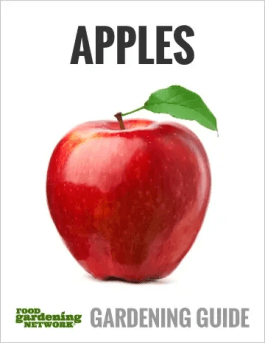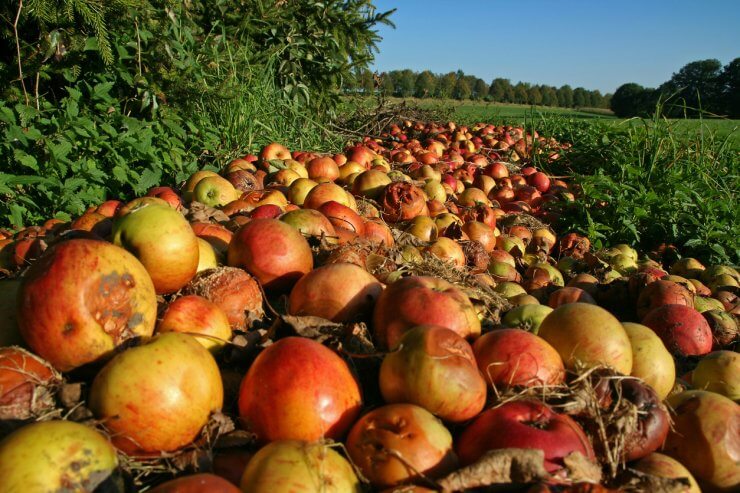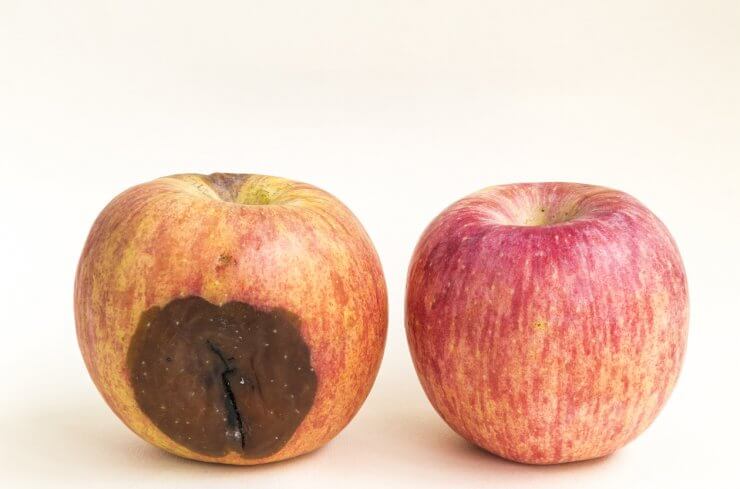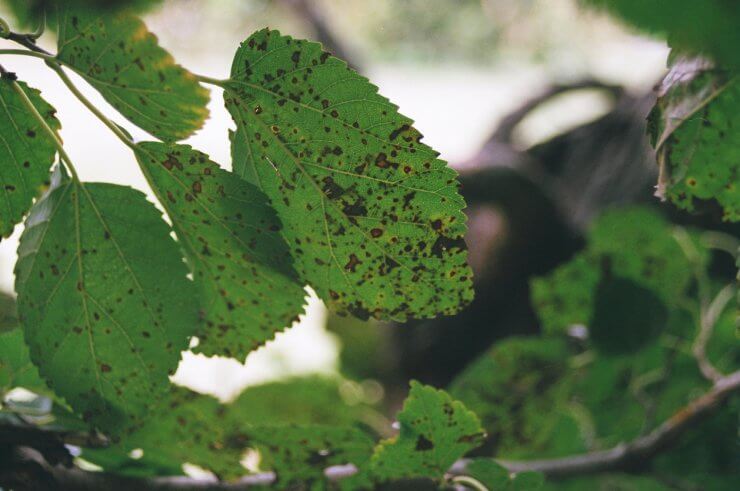
Apple diseases are particular to apples, so don’t try to use your knowledge of other tree and plant diseases when trying to identify different apple diseases. Remember that plants themselves can be hosts to organisms such as bacteria or fungi; however, the plant’s tissue is not infected. Therefore, symptoms will show on parts of the plant which we normally do not eat, like leaves, stems, and roots. In addition, apples have a short lifespan (when compared with most plants), and therefore there is less time for an apple disease to infect the whole tree. Most apple trees in home gardens live around 15-20 years before they die off.


Your apples have rough olive-green spots and velvety leaves that keep falling.
You have Apple Scab.
Apple scab is a fungus-like apple disease that causes brown lesions to grow on apple skins. This is a fungal infection that overwinters in fallen leaves and pruning debris. It grows in cool, wet weather and will survive all winter in dead wood and leaf litter around your apple tree. To treat, apply fungicide throughout the growing season, and prune and dispose of any diseased material. To prevent it, remove and destroy all infected/fallen leaves, plant scab-resistant trees, and disinfect gardening tools before using them on trees.

Your leaves are turning yellow, starting at the tips, then turning brown and falling off dead.
You have Anthracnose.
Anthracnose can be a death sentence for apple trees caused by a fungus that affects many plants, including apples, peaches, pears, roses, potatoes, and tomatoes. The fungus enters through wounds in stems or fruit then grows through the plant tissue. This damages the plant’s vascular system, eventually causing death as water cannot reach all parts of the tree or stem because lesions block them on leaves and branches. If all you are seeing is yellow-brown leaves though, don’t panic. To make a formal diagnosis, you’ll also need to look for dark, sunken lesions on fruit and/or stems. It spreads by rain and water but can be treated by quickly removing any infected limbs, clearing the ground around your tree, and applying liquid copper fungicide to reduce recurrence. To prevent it, prune your tree to provide good air circulation and access to sunlight.

You see small, brown sunken spots on apples that look like a target and rot fruit to the core and eventually mummify the fruit.
You have Bitter Rot.
This fungus, which overwinters in fruit left on your tree and in the limbs, produces mycotoxins which are poisonous to the tree and can be fatal to humans as well. It’s spread by rain splashing, which can spread spores. It can be treated by removing any and all affected limbs and prevented with a liquid copper fungicide, planting disease-resistant varieties, and pruning to increase airflow through trees. If you grow apple trees, you should check your trees often for this disease.

You see purple pimples on your leaves and black spots with red halos on mature fruit.
You have Frog-Eye Leaf Spot and/or Black Rot.
This is a disease that affects apple and crabapple trees. When it affects the apples, it’s called Black Rot, and when it affects the leaves, it’s called Frog-Eye Leaf Spot. On the apple, the fungus can get in through holes caused by hail, insects, or cracks, starting with a small brown spot that grows into large black spots until the apple turns black and mummifies on the tree. On leaves, you’ll see small purple flecks on leaves shortly after petal fall, and lesions grow with tan/brown centers and purple margins, resembling frog eyes. On the limbs, you’ll see red-brown sunken cankers. Like most other diseases, water and splashing water spreads spores. To treat, remove all affected limbs and apply liquid copper fungicide while also pruning trees to improve light and air circulation.

You see small, light yellow spots on upper leaf surfaces that turn orange with black specks and orange gel-like galls on cedar/juniper trees in spring.
You have Cedar Apple Rust.
Apple Cedar Rust is a fungus that spreads from cedar and juniper trees. You’ll also notice that fungal spikes develop on the underside of leaves. This fungus spreads to apple trees from cedar/juniper trees in the spring, and in fact, you may see its presence on your cedar/juniper trees first. Spores transfer back to cedar/juniper trees in dry weather, where they overwinter in the tree galls. Infection requires the presence of both apple trees and cedar/juniper trees for infection to spread. You can treat with neem oil and by removing infected branches. Prevent it by removing any cedar or juniper trees nearby.
Is there a disease you don’t see here?
In our Audacious Apples Gardening Guide we cover all the most common diseases that affect apple trees and so much more. Find out why you need a pollination buddy, and which apples are native to North America. Learn about it all in our Audacious Apples Gardening Guide right now!


 Previous
Previous

